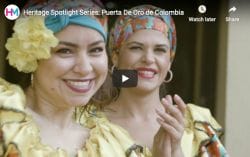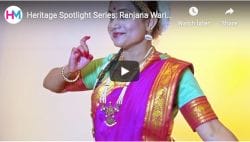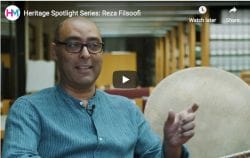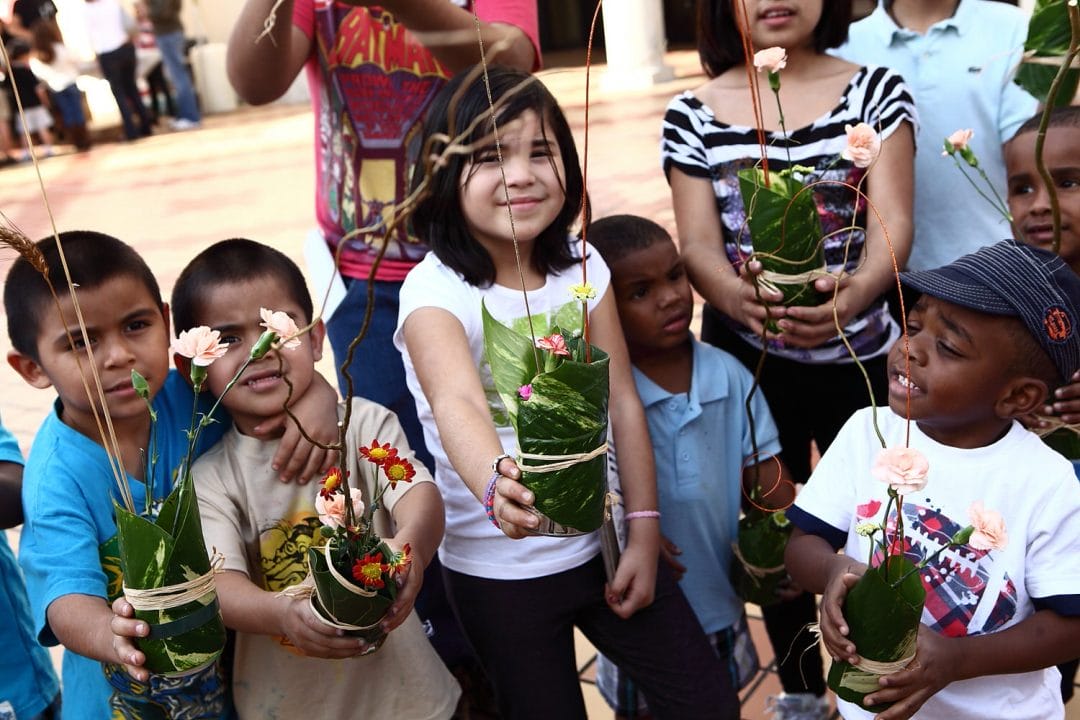
Children participate in an Ikebana (flower arranging) workshop led by 2012 artist-in-residence Mieko Kubota, a Japanese master ikebana artist, during Family Fun Day.
All photos courtesy HistoryMiami Museum.
Home to wanderers–almost everyone is from somewhere else and brought the best of where they were, to mix and mingle in merry mayhem–a haven surrounded by water topped by magically lit towers springing from glistening waters against a blazing sky–it’s magical. It’s Miami.
—HistoryMiami Museum anonymous survey response
What makes Miami, Miami? A stranger to Miami may answer this question by drawing from the city’s common portrayal as a tropical paradise, but many Miamians will tell you that this fascinating city is more than its beaches and weather. The city is richly complex under its glimmering surface, and exploring this complexity is essential to our work at HistoryMiami Museum. In its efforts to do so, the museum seeks to reflect the community’s diverse peoples and cultures, collaborate with the community in producing museum content, and create a welcoming institution for those it serves. Established in 1986, the South Florida Folklife Center (SFFC) is one of the organization’s essential mechanisms for accomplishing these goals. SFFC documents, presents, and supports the region’s traditional arts and cultural heritage and has embarked on many projects that have fed directly into the work of the museum’s collections, exhibitions, education, and marketing divisions.
This article examines how a focus on folklife at HistoryMiami Museum supports the institution in accomplishing its goal of fostering cultural equity. Specifically, the article highlights efforts at relationship building, facilitating and not prescribing opportunities for community self-expression and cross-cultural connections, co-creating public offerings with tradition bearers and community partners, and evaluating and adjusting our methods as we strive to represent our city’s mix of cultures. We believe that these approaches to cultivating a more equitable museum are applicable across various fields.
HistoryMiami Museum and its folklife division serve the population of South Florida with a focus on Miami, a transient city with a long history of migrants and travelers journeying in and out from all directions. Over centuries, and especially since the city’s incorporation in 1896, the diversity of peoples living in the region has been remarkable. Those who have made Miami home have roots in the Americas, Caribbean, Africa, Europe, and Asia, and include present-day Native American groups such as the Seminole and Miccosukee Tribes, originally from outside South Florida. Today, over 2.7 million people live in Miami-Dade County, 69 percent of whom are Hispanic or Latino, with more than half that population claiming Cuban ancestry. The Black community, which includes African American and Afro-Caribbean residents, makes up almost 18 percent of the total population, while the white, non-Hispanic population accounts for 13 percent (U.S. Census Bureau, Population Estimates Program). The city’s cultural landscape continues to evolve with constant waves of newcomers and visitors to Miami’s shores.
Our museum’s mission is to safeguard and share the diverse stories of our city. Through research, collections, exhibitions, education, and other endeavors, the museum fosters learning, inspires a sense of place, and cultivates an engaged community. In recent years, we have evaluated our effectiveness at achieving cultural equity in our work (both past and present), an endeavor that museum professionals across the world are taking on. Staff members have participated in national and international initiatives, including MASS Action convenings, the Of/By/For All Change Network, and a Universal Design workshop, and engaged in internal assessments, trainings, and more. To assess past and present failings and improve on how we reflect our community within the museum and represent it through our offerings, we continually engage in essential conversations on race, exclusion, authentic narratives, and other topics. Through examples of various folklife projects undertaken by the museum, this article explores some of our ever-evolving methods for achieving our equity-related goals.
MASS Action is a platform for public dialogue on a variety of topics and issues affecting our communities locally and globally, leading to actionable practices for greater equity and inclusion in our institutions.
Of/By/For/All equips civic and cultural organizations to become of, by, and for their communities by providing tools, community, accountability, and coaching on radical inclusion.
Universal Design is an approach to design that increases the potential for developing a better quality of life for a wide range of individuals. It is a design process that enables and empowers a diverse population by improving human performance, health and wellness, and social participation.
Our Work: Representing Our Diversity through Research, Collections, and Exhibitions
As a Colombian American, I am a proud bilingual and bicultural person. I know about the beauty and greatness of Colombia, and it is a pleasure to share a piece of these traditions with my fellow citizens of this great state.
—Rosmy Camargo, 2018 HistoryMiami Artist-in-Residence
For over three decades, folklorists and other museum staff members, along with a variety of community collaborators, built and programmed multiple types of folklife-related projects at the museum and throughout the city. Folklife initiatives have included documenting Miami traditions; collecting the material culture of the region; curating a long-term gallery dedicated to local cultural practices; creating temporary and online exhibitions; and organizing folklife festivals, performances, demonstrations, workshops, and other programs. Through this work, SFFC highlights the region’s folklife, which includes various types of expressive traditions learned through word of mouth or by example. These traditions are not learned in schools but through our involvement in folk groups such as families and ethnic, regional, occupational, or religious communities. Staff document many types of folklife, including music, dance, storytelling, handmade objects, foodways, rituals, occupational skills, and more. These practices are rooted in a community’s history and are dynamic, changing to meet contemporary needs. Our work strives to encompass the traditions practiced by South Florida’s varied cultures, and we aim to foster cultural equity by being inclusive of Miami’s myriad cultural groups within our research, collecting activities, and exhibitions.
Our collaborative research initiatives include partnerships with communities to document cultural practices through recorded interviews, still photography, videography, and fieldnotes. Staff rely on local stakeholders to identify key topics, individuals, and practices and have hired cultural insiders as contract fieldworkers for projects. SFFC has also partnered with and trained community members to document their own traditional culture. The resulting collection of archival documentation and artifacts, including religious items, musical instruments, textiles, and other objects, is accessible to the public and available for use by the museum. This process uses the research methods found in the discipline of Folklore and related ethnographic fields. We approach ethnography not only as researchers, but also as curators, taking into account the cultural groups and types of traditions we focus on over time. Through documentation, our team seeks to preserve traditional knowledge and acknowledge the value of a particular group or cultural practice. When determining upcoming projects, we inventory our past work, identify underrepresented cultures, and discuss the current dynamics of our community. These considerations inform next steps and allow us to think responsibly about our influence as a research institution.
Historically, much of the museum’s folklife work has emphasized greater Miami’s racial, national, and ethnic diversity. We feel that it is essential that staff reflect on personal biases in selecting research topics, so we complicate the notion that “diversity” refers to only race, nationality, and ethnicity. Many past initiatives have focused on cultural groups who have been underrepresented at the museum and in museums throughout time, including our city’s African American, Bahamian, Colombian, Cuban, Haitian, Nicaraguan, Peruvian, Puerto Rican, Trinidadian, and Venezuelan communities. We have also made an effort to concentrate attention on religious, regional, occupational, and other folk groups. A selection of past research projects, each resulting in public educational offerings, include Jewish Traditional Arts, Folk Arts of the Florida Keys, Afro-Cuban Orisha Arts in Miami, the Florida Jai-Alai Project, and the Guayabera Preservation Initiative. Through SFFC’s work, the museum has sought to document various forms of cultural expression to deepen understanding about local traditional practices and inspire a feeling of belonging in the larger community.
SFFC understands that it must evolve to remain responsive to the community and its ecosystem of traditional artists and cultural organizations. In 2007, we initiated the Artists Access Survey project. The purpose was to determine how the self-identified needs of Miami-area folk artists and folk arts organizations correlated to the museum’s resources. Much of the critical feedback guided SFFC in outlining new ways to serve the area’s traditional artists and arts groups better. The survey informed the creation of SFFC’s current menu of programmatic offerings and the creation of the Folklife Gallery. Although over a decade has passed, these recommendations continue to guide our planning, and future goals include creating a small grants program and a support network for local artists and cultural institutions.
Because of its city-centric focus, SFFC also aims to respond to the community at large and changes or trends in Miami. Although some locals describe their relationship with Miami as a “love-hate” dynamic, the last decade or so has seen a growing movement of civic pride, including community-driven explorations of “Miaminess.” In response, over the last five years, some SFFC research projects have ventured beyond documenting the cultural practices of a specific folk group to investigating the distinct cultural practices of the city. Such projects include the What Makes Miami, Miami? Project and the Miami Street Culture Project. Focusing on topics of this kind enables us to explore our collective sense of place and how people create a sense of community in an exceptionally diverse and fragmented city. These Miami-centric projects are an opportunity to work with new types of tradition bearers, work in diverse geographic regions of the county, and produce educational products that aim to inspire a feeling of connection.
For most of its history, SFFC’s exhibition initiatives included temporary shows that appeared in the museum’s exhibitions calendar every few years. These have included Tropical Traditions: the Folklife of Southeast Florida, At the Crossroads: Afro-Cuba Orisha Arts in Miami, Haitian Community Arts, The Guayabera: A Shirt’s Story, and Avenues of Expression: Street Traditions in Miami. Some exhibitions have been co-curated with traditional experts. An example is At the Crossroads, which highlighted the religious practices and handmade ritual items of Orisha practitioners. Miami is one of the major centers of the Afro-Cuban Orisha religion, and its array of traditional arts is practiced by numerous specialists who produce beadwork, textiles, metalwork, woodcarvings, altars, and other items. The exhibition was co-curated by members of the religious community, and practitioners built ceremonial thrones within the space. For the exhibition, the museum also commissioned local artists to create ritual items, many of which were added to the permanent collection.
Explore SFFC Online Exhibitions
At the Crossroads: Afro-Cuban Orisha Arts in Miami http://www.historymiami.org/at-the-crossroads-afro-cuban-orisha-arts-in-miami/
The Guayabera: A Shirt’s Story http://www.historymiami.org/wp-content/themes/historymiami/assets/guayabera.html (See also JFE 2014 The Guayabera and Cultural Research.)
The SFFC’s exhibition efforts evolved in June 2014, when the museum opened the South Florida Folklife Gallery as a space to educate visitors on the area’s cultural diversity and expressive traditions that give the region its unique character. The gallery features artifacts from the museum’s collection and serves as a venue for performances, demonstrations, and other cultural programs. The addition of the Folklife Gallery provided SFFC new opportunities to engage the public and interpret local culture. On display is a selection of communal, familial, occupational, and religious folk crafts and objects from different cultural groups. We often rely on partnerships with local artists and organizations to acquire objects for the museum’s collection and, to facilitate representation, typically encourage them to recommend what best represents their tradition, culture, or community. The museum acquired the majority of the items in its collection and in the gallery through folklife research projects. We continue to add to the collection by identifying “gaps” in our representation of significant facets of Miami’s traditional culture. During each annual gallery rotation, our staff inventories the array of communities and folklife genres represented throughout the gallery’s history as part of our ongoing commitment to showcasing traditional practices not yet featured. The Folklife Gallery also includes a stage, which is used as a temporary display area and a programming venue for music and dance performances, live demonstrations, workshops, and other presentations.
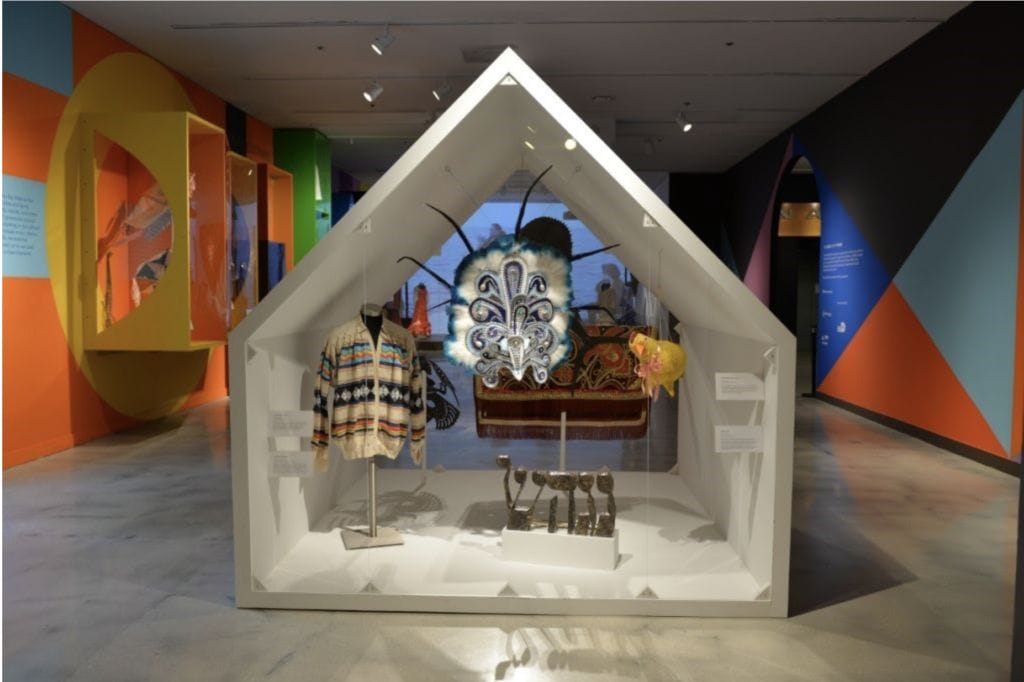
HistoryMiami Museum’s Folklife Gallery, 2015.
Facilitating Cultural Expression through Public Programs: A Closer Look
Indian dances are very diverse and truly represent a country that is a melting pot of varied cultures. It provides me with the most effective canvas to engage, to educate, and to entertain an audience.
—Ranjana Warier, 2016 HistoryMiami Artist-in-Residence
Since SFFC’s establishment, folklife staff have produced a variety of cultural programs. This includes collaborations with the museum’s Education Department to offer programming for schools, families, and other audiences. Today, SFFC’s annual programming includes two artist residencies, Cultural Encounters programs, and CultureFest 305, a folklife festival. All our programs rely heavily on partnerships with traditional artists and community partners. While developing each program or program component, we co-create the content with our partners and follow the lead of traditional artists as to which aspects of their culture they would like to highlight and the best mechanisms for doing this. SFFC aims to serve as a facilitator for cultural expression and cross-cultural learning, and staff view museum resources such as gallery spaces, programs, and webpages as opportunities for tradition bearers to represent themselves to the general public.
In 2012, SFFC launched an artist-in-residence series that became the department’s primary program focus, and has, for the most part, presented traditions tied to ethnicity and nationality. In the last few years, we have made a conscious effort to diversify the types of identities we highlight and have created additional, more flexible programming mechanisms to explore religious, occupational, and regional cultures. SFFC’s residency program has presented 22 Miami-area traditional artists, including a Cuban tres guitar builder, a Haitian storyteller, and a Jewish textile artist. Each year, the series showcases two individual artists or ensembles and their traditions, and participating artists share their art through public events, school programs, and multimedia products. Each four-month residency includes three public programs at the museum, one youth program, and one outreach program with a community partner.
We intentionally curate the series to ensure that we present a variety of artists, local communities, and folklife genres over time. Although we organize each residency into five programs, we collaborate with each artist or ensemble to co-create these offerings. Staff present minimal parameters, encourage experimentation, and pose guiding questions to each artist. These questions include:
What are your goals for your residency?
What do you want others to learn about the tradition(s) you practice?
How can audiences engage meaningfully with your tradition(s)?
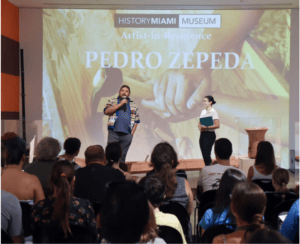
2019 artist-in-residence Pedro Zepeda offers a demonstration on the Folklife Gallery stage.
During the planning phase for each residency, we also ask artists to share stereotypes or misconceptions about their culture and discuss ways to address these throughout the collaboration. For example, Seminole artist Pedro Zepeda spoke to our staff about the public’s common misconception that Native American culture is “stuck in the past.” During his residency, Pedro addressed this notion by describing himself as both a traditional and contemporary artist and showcased a selection of his woodwork, basketry, sculptures, and paintings in our Folklife Gallery. With Pedro, we developed each residency program to provide opportunities for one-on-one engagement with the public and informal conversations exploring these public misunderstandings.
Many of our residency programs take place in the Folklife Gallery, and the gallery’s versatile stage also allows us to produce short-term exhibitions that showcase resident artists, as well as the material culture of celebrations in specific religious and cultural calendars. As part of our artist-in-residence series, the Instituto Cultural de Mexico Miami created an ofrenda (a Día de Muertos altar) in conjunction with the residency of Ameyal Mexican Cultural Organization. The museum hosted a Día de Muertos celebration, well attended by members of the local Mexican community and the general public. The event provided a space for the Mexican community to commemorate the holiday and attendees unfamiliar with the tradition to learn more. Similarly, in preparation for a Persian New Year celebration, the Iranian American Foundation used the gallery’s stage to create a haft-seen, a table display central to the holiday. Despite its small population, Miami’s Iranian community participated in full force, enthusiastically singing and dancing along with the performance. Through this exhibition and program, the museum transformed from a place for learning to a place for communal expressions of religious and cultural practices.
Although successful, the series is limited to highlighting a few traditions per year and excludes master artists who are unable to participate in a residency but are otherwise ideal for other types of programs. In response, SFFC launched the Cultural Encounters series in 2017, enabling us to showcase artists, communities, and folklife genres (such as occupational traditions) rarely covered in residencies. Cultural Encounters includes intimate experiences at local businesses, workspaces, and other locations for small groups of participants to go behind the scenes and learn from the artisans whose crafts, skills, and services make Miami, Miami. Similar to our recent Miami-centric research projects, these programs celebrate the city’s distinct character, foster a sense of place, and connect locals to each other. Programs have included a live demonstration and conversation with a cigar roller and a tropical horticulture workshop at a botanical garden and park.

A Nowruz haft-seen display created by the Iranian American Foundation on the Folklife Gallery stage in celebration of the Persian New Year, 2019.
We co-create these events with partners and seek to facilitate meaningful connections. By limiting participation to a small group, we encourage open conversations. Featured artisans, business owners, and other local experts share their knowledge and personal stories, while participants ask questions and explore their curiosity in an informal setting. These events can also break down stereotypes about misunderstood traditions. During a tour of a local Afro-Caribbean religious store called a botánica, participants learned about the religious communities the shop serves. The fruitful conversation with the owner addressed misconceptions and explored topics such as “black magic” and animal sacrifice. The experience allowed participants to develop a more empathetic understanding of the religious practices, and they described it as “unforgettable.”
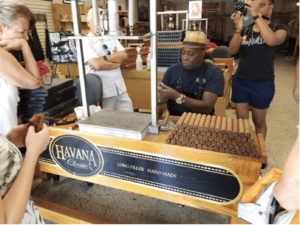
Participants gather for a cigar rolling demonstration during a Cultural Encounter at Havana Classic Cigars, 2018.
In 2017, SFFC piloted the first CultureFest 305, a free folklife festival featuring performances, demonstrations, craft activities, storytelling, and more. The festival explores the question “What makes Miami, Miami?” and each year we showcase tradition-bearers, folk groups, organizations, and businesses that, in the collective, answer this question. Although the festival celebrates Miami’s various cultures, this organizing theme focuses attention on the city’s identity in an effort to inspire feelings of communal unity and belonging. CultureFest 305 is not only an opportunity to celebrate local diversity, but also a mechanism for building relationships with artists, organizations, and other partners. This festival is highly collaborative, involving over 30 partners that include traditional artists, community organizations, food vendors, and others. In addition to scheduled performances and demonstrations, the festival includes an ongoing demonstration area that features a dozen tradition bearers and organizations. Envisioned as more than information tables, these spaces are opportunities for the public to engage meaningfully with the featured tradition. SFFC works with each partner to co-create an activity or offering that is both informative and builds a connection. Additionally, the museum has focused on improving the festival’s accessibility, including reallocating funds toward ASL interpretation and purchasing craft supplies appropriate for children and adults of all abilities.

Delou Africa Dance Ensemble leads an interactive performance at the 2018 CultureFest 305.
Education Initiatives: Teaching for Equity
Through my practice, I hope I encourage my audience to get to know the Iranian people and culture and their many contributions to humanity. I hope that the sound of my music will take them beyond the immediate stereotypes that have created a wall between our two countries.
—Reza Filsoofi, 2019 HistoryMiami Artist-in-Residence
Our Education Department welcomes opportunities to share the community’s varied experiences, stories, and cultures with students and families through programs, exhibitions, and social media. The museum is committed to serving South Florida’s students, teachers, and adult learners through exciting, innovative programs that bring over 10,000 years of South Florida’s history to life. We design education programs to provide age- and grade-level appropriate experiences, focusing on different learning modalities. Programs elicit critical thinking as students compare and contrast the past and present and are encouraged to visualize and discuss what the future may be like, based on patterns of the past.
Folklife programs are one of many types of Education Department offerings. Museum educators use Folklife Gallery exhibitions in formal and informal ways to explore the diversity of local culture and introduce the concept of “folklife” with school groups, nonprofit organization leaders, university students, adult groups, and community stakeholders. Staff begin the gallery tour by breaking down the institution’s definition of folklife, asking essential questions, and engaging in dialogue to make connections. These discussions encourage participants to build empathy and reflect on and connect with personal cultural practices. Discussions center on each participant’s folk expressions and the familial and communal context of these traditions. During these conversations, each person adds value as they share, and we aim to create a sense of community that welcomes various points of view and experiences. Example questions include:
What is traditional culture, or folklife?
How is culture retained?
How are cultural traditions passed on?
How does culture change?
How do people carry culture with them to new places?
What is your favorite holiday/festival/special family occasion?
What is your favorite thing to eat during these occasions?
What are special sayings that your family uses?
Focusing on folklife also validates informal learning in a way that institutional learning and schooling do not, and this inspires relationship building and amplifies under-recognized cultural contributions. The value placed on informal learning is essential when working with students. For example, the school program component, co-developed with resident artists, allows the museum to introduce students to Miami’s diverse cultural heritage through interactive presentations of local folk traditions led by some of South Florida’s expert traditional artists. Students in Miami-Dade County Public Schools engage with local artists and our staff folklorist without leaving the classroom. Schools and administrators face difficult budgetary realities, and additional funds for art initiatives are not always available. This component of our residency program supports authentic arts engagement one classroom at a time, even at a small scale. While these free programs are available to all local educators, some school programs are tailored to specific groups for a more significant impact. During the residency with The Lee Boys, who practice an African American gospel music tradition called “sacred steel,” the ensemble offered a workshop for Guitars Over Guns, an organization that delivers arts-based mentoring programs to empower youth in underserved neighborhoods where many art programs in schools have faced budgetary cuts. This experience was memorable for not only the music students, who were fascinated by the band’s lap steel guitar, but also for the band’s members, who enjoyed sharing their stories and learning from the youth.
In recent years, the museum has modified the classroom component of the artist residencies to be useful in alternative educational settings such as libraries, after-school programs, community centers, and camps. As an example, we partnered with Miami-Dade County’s Juvenile Services Department to bring their youth cohort to the museum to meet Reza Filsoofi, an Iranian musician specializing in multiple instruments, including santoor and setar (stringed instruments) and daf and tonbak (percussion instruments). The group learned about Persian culture, played instruments, and gained an understanding of the cultural context for these traditions. The workshop provided an intimate hands-on educational experience. Reza’s journey as a musician and the time and dedication required to reach his level of expertise fascinated the participants, some of whom were musicians as well. Organically, the program ended with a group conversation on how music can enrich lives by providing purpose and fulfillment. Through programs such as this, the museum aims to create spaces for youth of all backgrounds to connect with one another and the broader Miami social landscape, learn about different communities, and break down stereotypes.
Through our Family Fun Day program, the artist residencies provide another educational opportunity. Once a month, we host a free family-oriented day of programming, including crafts, tours, music, and art activities to engage our community stakeholders and families. Each artist-in-residence participates in a Family Fun Day, and museum staff intentionally collaborate with other local guest artists, vendors, and community groups on this day to provide additional cultural context and opportunities for learning about the resident artist’s traditional practices. Dance ensemble Puerta de Oro de Colombia, for example, brought their passion for Colombia’s vibrant traditions to a Family Fun Day. Attendees experienced live music and dance performances, craft activities, hands-on music-making, traditional Colombian cuisine, costumes, and bilingual storytelling. The presence and contributions of the local Colombian community proved integral to the success of this well-received event. From vendors to guest artists to attendees, the Colombian community participated in full force to celebrate their culture with Miami at large. Similar to past holiday-related programs, this Family Fun Day provided a space for community expression and an engaging learning experience for the general public.
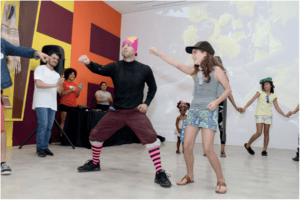
2014 artists-in-residence Flipside Kings, a B-Boy dance crew, lead an interactive presentation during Family Fun Day.
Because of its versatility as a community space, we have also used the Folklife Gallery in informal ways not directly tied to a particular artist or folk group but focused on fostering equity and inclusion. Last year, we had the privilege of partnering with a local organization with the mission “to prevent suicide and ensure the healthy development of all youth through powerful communication and education on gender and orientation.” We met with their LGBTQ+ youth advisory committee to discuss their interest in working with the museum. Our staff was in the midst of planning an exhibition around queer history in Miami, and we invited the cohort to work with us on a youth component tied to the exhibition. Through various workshops and meetings, we developed a relationship with the group over time, and they opted to create their own exhibition in response to the Queer Miami exhibition and the gaps they identified surrounding LGBTQ+ youth issues. They focused on gender and the negative impact of stereotypes and had total control over the project, including the featured content and the exhibition design. We used the Folklife Gallery to create their exhibition, setting up art supplies and ten real doors to use as canvases. The Folklife Gallery created a welcoming and inclusive space for the group, the majority of whom are Black and Brown youth, ages 13-21. The partnership empowered these individuals, amplified their voices, and attended to the absence of a youth voice at the museum.
Closing Words
Participating in Junkanoo gives you a feeling of release, passion, and pride as you see how observers become mesmerized by its unique sounds. There is a reward in bringing joy to others who may otherwise have a grim day.
—Langston Longley, 2014 HistoryMiami Artist-in-Residence
In all that we do, HistoryMiami Museum staff are committed to serving as a genuine partner to community collaborators and to implementing initiatives as inclusive as possible, being mindful of the cultures we have or have not represented. By co-creating educational experiences with folk artists and community partners, we serve not as managers, but as facilitators of projects, expanding our capacity for undertaking equitable work. We view this work as flexible, responsive, and ever evolving as we constantly reflect on our impact and adapt accordingly. There is, of course, more work to be done, and we seek to build on the strategies discussed in this article to improve our service to the community. We will continue to address internal biases, interrogate our methods of representation in research, collections, exhibitions, and programming, and improve the accessibility of our spaces and programs. When community stakeholders see themselves represented in our initiatives, are fully engaged in collaborative efforts, and feel invested in our collective endeavors, we can build meaningful relationships and cultivate a sense of a common humanity.
Michael Knoll, Director of Curatorial Affairs and Chief Curator, oversees HistoryMiami Museum’s Archives and Research Center, object collection, exhibitions, and folklife division. During his tenure as the museum’s Folklorist, he directed several fieldwork projects, including the Florida Jai-Alai Project; established the artist-in-residence program; curated the award-winning exhibition The Guayabera: A Shirt’s Story; and created the Folklife Gallery. He has also worked with the Wisconsin Arts Board, the Smithsonian Institution, and the Jewish Museum of Florida, and he serves on the board for Local Learning. He studied Folklore at the University of Wisconsin and the University of North Carolina.
Tina Menendez, Director of Education at HistoryMiami Museum, has worked in public school education, cultural education, and nonprofit management at various organizations in Chicago and South Florida for over 25 years. The Education Department at HistoryMiami Museum includes Public Programs, School Programs, City Tours, Outreach, and Visitor Services. Tina holds an EdD from the University of Illinois at Chicago in Urban Education Leadership and Public Policy. She has been with HistoryMiami Museum since 2016 and has developed and sustained partnerships with numerous community organizations, museums, and schools.
Vanessa Navarro Maza, Folklife Curator, directs HistoryMiami Museum’s South Florida Folklife Center. She curates exhibitions in the museum’s Folklife Gallery and conducts fieldwork and collecting projects such as the What Makes Miami, Miami Project research initiative commissioned by the Florida Folklife Program and the Miami Street Culture Project, resulting in the exhibition Avenues of Expression: Street Traditions in Miami, which she curated. She also develops educational programs, manages the artist-in-residence program, and established the Cultural Encounters series and CultureFest 305 Folklife Festival. Additionally, she creates media products about local folklife and assists the region’s traditional artists. She studied Anthropology at the University of Florida and Ethnomusicology at Florida State University.
URLs
South Florida Folklife Center http://www.historymiami.org/folklifecenter
Museum as Site for Social Action https://www.museumaction.org
OF/BY/FOR ALL https://www.ofbyforall.org
Universal Design http://www.universaldesign.com
How HistoryMiami Empowered LGBTQ+ Youth with a Project OF and BY Them https://www.ofbyforall.org/updates-feed/2019/5/10/how-historymiami-empowered-lgbtq-youth-with-a-project-of-and-by-them
What Makes Miami, Miami? Project Report http://www.historymiami.org/wp-content/uploads/2019/12/FFP-Report-What-Makes-Miami-Miami.pdf
Miami Stories http://www.historymiami.org/miamistories
Artist-in-Residence Meet-the-Artist Video Playlist https://www.youtube.com/playlist?list=PL-6bEPO8PMxjWRNkzdnE6iBKQgvtOsTzg
At the Crossroads: Afro-Cuban Orisha Arts in Miami http://www.historymiami.org/at-the-crossroads-afro-cuban-orisha-arts-in-miami/
The Guayabera: A Shirt’s Story http://www.historymiami.org/wp-content/themes/historymiami/assets/guayabera.html
Guayabera in JFE 2014 https://jfepublications.org/wp-content/uploads/2018/10/bowman-from-JFE2014Vol1reducedsize-15.pdf
SFFC Artist-in-Residence Series http://www.historymiami.org/folklifecenter/artist-in-residence

